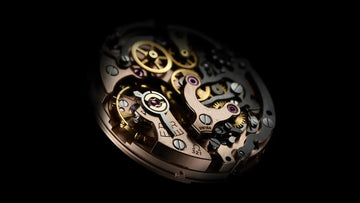Meticulous Selection of Premium Elements
Every Kloira watch is crafted with precision, using only the highest quality materials. From the brilliance of diamonds to the strength of stainless steel, we ensure that each component meets our exacting standards, delivering a timepiece that radiates elegance and sophistication.

Signature Materials that Define Luxury
Stainless Steel:
Renowned for its robustness and classic appeal, providing a timeless and durable finish that complements any style.
Ceramic:
Offers a sophisticated, modern look with exceptional scratch resistance and lightweight comfort, ideal for everyday wear.
Titanium:
Bold designs that incorporate standout elements like elaborate diamond settings and unique case shapes, perfect for making an impression.
Diamond Like Carbon (DLC):
Watches designed to transition seamlessly from day to night, with high-quality materials and versatile styles that complement any outfit.
Premium Materials, Timeless Quality



Rubber Straps
Rubber straps are ideal for active lifestyles, offering water resistance and durability while providing a modern, sporty look.
Diamond Embellishments
Hand-selected diamonds enhance the beauty of our timepieces, adding a touch of opulence and elegance to every watch.
Leather Straps
Crafted from premium leather, our straps offer a timeless appeal and unmatched comfort, aging gracefully over time.

Mastering the Art of Material Excellence
Exceptional Materials for Exceptional Timepieces
"Kloira's commitment to excellence is evident in the durability of our materials. We use sapphire crystal for its exceptional clarity and resistance to scratches, ensuring that your watch maintains its pristine appearance over time. Our stainless steel cases are selected for their strength and resistance to corrosion, blending resilience with refined elegance.
Each component of a Kloira watch is meticulously crafted to uphold our standards of quality. The diamonds we use are set with precision, enhancing the watch's beauty while withstanding everyday wear. Our focus on premium materials ensures that every timepiece not only captivates with its style but also stands the test of time, making each Kloira watch a lasting symbol of sophistication and durability."
More Guide
Frequently Ask Question
What are the different movements in watches?
Watches typically feature three main types of movements: manual, automatic, and quartz. Manual movements require daily winding and are known for their traditional craftsmanship. Automatic movements self-wind through the wearer’s wrist motion, offering convenience without daily winding. Quartz movements, powered by a battery, provide superior accuracy and require minimal maintenance. Additionally, hybrid movements like kinetic and solar combine mechanical and quartz elements for enhanced functionality.
Which movement is best for watch?
The best movement depends on personal preferences. Manual movements are ideal for traditionalists who enjoy daily winding. Automatic movements offer convenience through self-winding. Quartz movements are perfect for those who prioritize accuracy and low maintenance. Each type has its advantages, and the choice depends on whether you value heritage, convenience, or precision in your timepiece.
What is a chronograph watch movement?
A chronograph is a multifunctional movement that combines traditional timekeeping with stopwatch functionality. Chronograph watches usually have additional sub-dials for measuring elapsed seconds, minutes, and hours, along with pushers on the side of the case to start, stop, and reset the timer. These watches are often used for athletic timing, aviation, or motorsports.
Which type of motion is watch?
Watches utilize either mechanical or electronic motion. Mechanical watches, including manual and automatic, operate through gears and springs. Quartz watches use electronic motion, powered by a battery and a quartz crystal. Mechanical movements create a consistent ticking motion, while quartz movements offer high accuracy through precise vibrations.
How to choose a watch movement?
Choosing a watch movement involves considering your lifestyle and preferences. Manual movements suit those who appreciate traditional craftsmanship. Automatic movements are convenient, self-winding through wrist motion. Quartz movements prioritize accuracy and low maintenance. Consider factors like budget and desired features to select the best movement for your needs.
Which watch movement is most accurate?
Quartz movements are the most accurate, powered by a battery and a vibrating quartz crystal. They lose or gain only a few seconds per month. In contrast, mechanical movements, including manual and automatic, have variations of several seconds per day. Quartz watches are preferred for their superior accuracy.
What movement do luxury watches use?
Luxury watches predominantly use mechanical movements, including manual and automatic, due to their intricate craftsmanship. High-end brands often develop in-house movements, ensuring exclusivity and superior quality. While quartz movements are less common, some luxury brands offer high-end quartz models for unparalleled accuracy.
Which is better, quartz or automatic watch?
The choice between quartz and automatic watches depends on preferences. Quartz watches are highly accurate, low-maintenance, and affordable, requiring only periodic battery changes. Automatic watches are cherished for their craftsmanship and heritage, self-winding through wrist motion. Choose quartz for precision and convenience, automatic for traditional mechanical appeal.
Which watch movement is more expensive?
Mechanical movements, including manual and automatic, are generally more expensive than quartz movements due to intricate craftsmanship and complex engineering. Brands that develop in-house movements command premium prices. Quartz movements are simpler and cheaper to produce, making quartz watches more affordable, though high-end quartz models can be expensive.
How to tell if a watch is automatic?
To identify an automatic watch, observe the second hand’s smooth, sweeping motion, unlike the ticking motion of quartz watches. Check if the watch self-winds with wrist motion. Many automatic watches have a transparent case back to view the movement. Listen for a continuous ticking sound, different from quartz watches’ distinct ticks.




























